To photograph clear cell specimens, use 100x oil immersion objective with Perfect Focus System engaged. Set low ISO (200-400), aperture between f/4-f/5.6, and fast shutter speed (1/1000+). Implement Kohler illumination and phase contrast techniques for enhanced cellular detail. For thorough focus, capture multiple z-stack images (3-40 depending on magnification) and combine them with specialized software. Proper maintenance of optics guarantees consistently sharp images across numerous specimens.
Optimal Focus Settings: Photograph Clear Cell Specimens
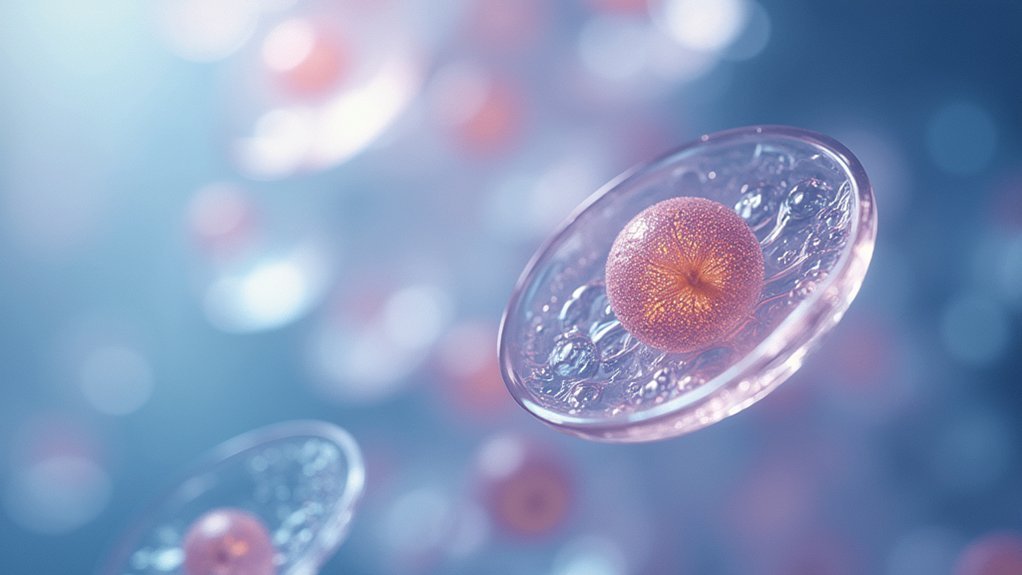
When preparing to photograph clear cell specimens, you’ll need to properly engage the perfect focus system (PFS) by carefully raising the objective until the oil makes contact with your sample.
Use a trinocular head that allows simultaneous viewing and photography for ideal results.
Set your objective to 100x oil immersion for enhanced detail and greater depth of field. The coverslip shouldn’t exceed 1mm thickness to maintain precise focus.
Begin with coarse adjustment to bring cells into light view, then fine-tune focus for maximum clarity.
Clean your objectives and coverslips regularly to prevent contamination that causes blurry images. Confirm proper PFS engagement by checking for coverslip reflection.
Once your cells are in sharp focus, save these settings for consistent imaging results in future sessions.
Microscope Setup for Transparent Specimens
To properly visualize transparent specimens, you’ll need to master Kohler illumination by aligning your light path and centering the condenser for ideal contrast.
Phase contrast methods enhance cellular details by converting phase shifts into amplitude differences, making invisible structures visible without staining.
You can further improve your imaging by adjusting the phase annulus to match your objective precisely, ensuring maximum contrast when examining unstained cells.
Kohler Illumination Technique
Establishing proper Kohler illumination transforms how you’ll view transparent cell specimens under the microscope. This technique guarantees even illumination across your specimen, dramatically enhancing image clarity and contrast.
Begin by centering the light source in your field of view. Then adjust your condenser to create a sharp image of this light source before focusing on your specimen. You’ll need to fine-tune the diaphragm to control light reaching the specimen—this reduces glare and improves resolution of transparent samples.
For peak results with transparent cells, combine Kohler illumination with phase contrast or differential interference contrast (DIC) techniques. These methods reveal fine cellular details that would otherwise remain invisible.
Don’t forget to regularly clean all optical components, particularly the condenser and objectives, to maintain your Kohler illumination setup’s performance.
Phase Contrast Methods
While Kohler illumination creates an excellent foundation, phase contrast microscopy takes transparent specimen visualization to another level. This technique transforms invisible phase shifts into visible brightness variations, revealing cellular structures without staining.
To achieve sharp focus with phase contrast, make sure your microscope is properly configured. First, verify that phase contrast objectives are correctly aligned with their corresponding phase rings in the optical pathway.
Use a dedicated phase contrast condenser that provides the necessary annular illumination for creating ideal contrast. Adjust the condenser diaphragm carefully to control light input, which greatly impacts image clarity and detail definition.
Remember to clean all optical components regularly, as dirt and debris can diminish image quality.
With proper setup and maintenance, you’ll capture stunningly detailed images of otherwise invisible cellular structures.
Light Management for Cellular Clarity
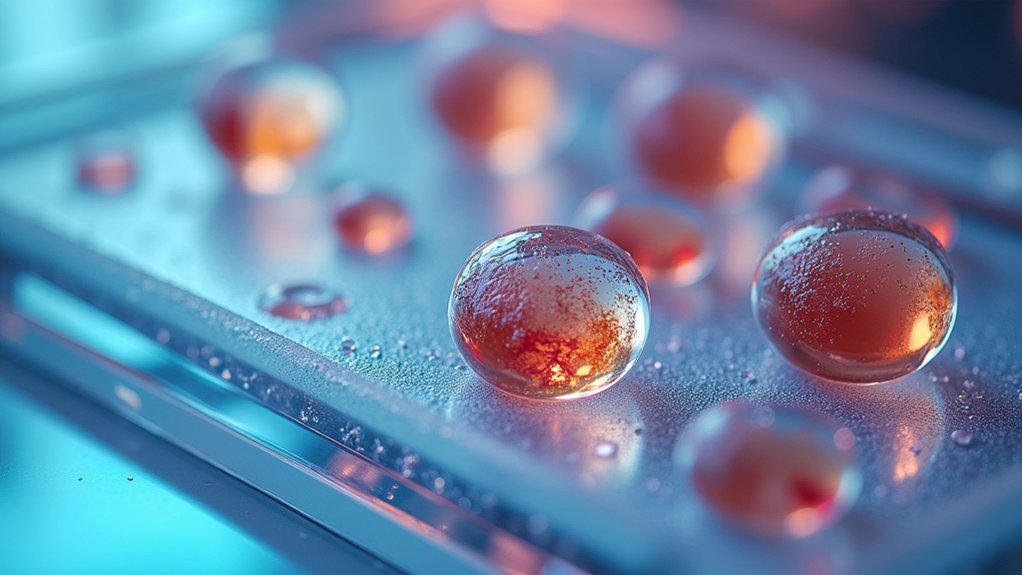
Proper illumination serves as the cornerstone of successful microscopic examination, especially when working with clear cell specimens.
You’ll achieve optimal contrast by utilizing bright field illumination with evenly distributed light sources to eliminate shadows that can obscure cellular details.
For transparent structures, incorporate oblique illumination to create depth and enhance fine details.
Adjust your light intensity carefully—LED sources provide ideal brightness while generating minimal heat that could damage delicate specimens.
LED lighting offers optimal illumination intensity without excessive heat that could compromise sensitive microscopy samples.
Don’t overlook polarizing filters, which greatly reduce glare in transparent or semi-transparent samples, revealing structures that might otherwise remain invisible.
Remember to maintain your equipment by regularly cleaning optical surfaces and verifying proper alignment of light sources.
This maintenance prevents artifacts that could compromise the clarity of your photomicrographs and guarantees consistent results.
Depth of Field Control for Single-Cell Imaging
You’ll need to carefully select your aperture settings (f/2.8-f/4) to create the shallow depth of field necessary for isolating single-cell specimens from their background.
Maintaining precise focus at the cellular focal plane requires stabilizing your microscope-camera setup and using the perfect focus system when working with high-magnification objectives like the 100x oil immersion.
For capturing the full cellular structure with maximum clarity, implement z-stack imaging techniques that combine multiple images taken at different focal points into one thoroughly focused composite.
Aperture Selection Strategies
Selecting the appropriate aperture setting stands as one of the most critical decisions when imaging cell specimens. For isolated single-cell photography, choose a wide aperture (f/2.8 to f/4) to create shallow depth of field that emphasizes your subject against a pleasingly blurred background.
When you need to capture multiple cellular layers clearly, switch to narrower apertures (f/8 to f/16). This increases your depth of field, bringing more of the specimen into focus.
However, be cautious with extremely small apertures as they can introduce diffraction effects that reduce overall sharpness.
Remember to adjust your shutter speed or ISO accordingly when changing aperture settings to maintain proper exposure.
For complex specimens, consider implementing focus stacking techniques alongside your aperture selection strategies to achieve maximum clarity across all cellular regions.
Focal Plane Precision
Because cellular structures exist at microscopic scales, mastering focal plane precision becomes the cornerstone of successful single-cell imaging. At high magnification, even minuscule adjustments can dramatically affect image clarity due to the extremely shallow depth of field.
You’ll achieve more accurate results by implementing a Perfect Focus System (PFS). This technology automatically locates and maintains the focal plane despite sample movement or environmental vibrations. When using PFS, start with coarse adjustments until cells become visible, then make fine adjustments for ideal detail.
Always calibrate your focal plane settings based on coverslip thickness, keeping it under 1mm to prevent distortion.
Remember to maintain clean optics and properly mount your specimens—contamination creates artifacts that can obscure the focal plane and compromise your imaging precision.
Z-Stack Imaging Techniques
When examining complex cellular structures, a single focal plane often proves insufficient to capture all relevant details. That’s where z-stack imaging becomes invaluable, allowing you to create composite images with enhanced depth of focus.
To implement this technique effectively, capture 3-40 images at different focal planes throughout your specimen. You’ll need a stable setup to prevent vibrations that could blur your results.
Pay careful attention to lighting and contrast at each level to guarantee all planes are well-illuminated.
After acquisition, use specialized software like Helicon Focus or Photoshop to combine these images into a single composite. This process overcomes the limitations of shallow depth of field at high magnifications, revealing intricate cellular details that would otherwise remain obscured in conventional single-plane microscopy.
Focus Stacking Techniques for Cellular Structures
Five distinct layers typically exist in complex cellular specimens, making traditional single-focus microscopy insufficient for capturing all details clearly.
Focus stacking solves this limitation by combining multiple images taken at different focal depths into one thorough photograph with superior image quality.
To effectively stack cellular structures, you’ll need to capture 3-40 images depending on your magnification—more images are necessary at 20X or higher.
Make sure your optics are spotless and specimens are properly prepared to prevent artifacts that compromise clarity.
Use a stable support and cable release to minimize vibration during capture.
Process your stack with specialized software like Helicon Focus or Photoshop, which will align and blend the images into a seamless final result revealing all cellular layers with exceptional sharpness and detail.
Camera Adapter Positioning and Calibration
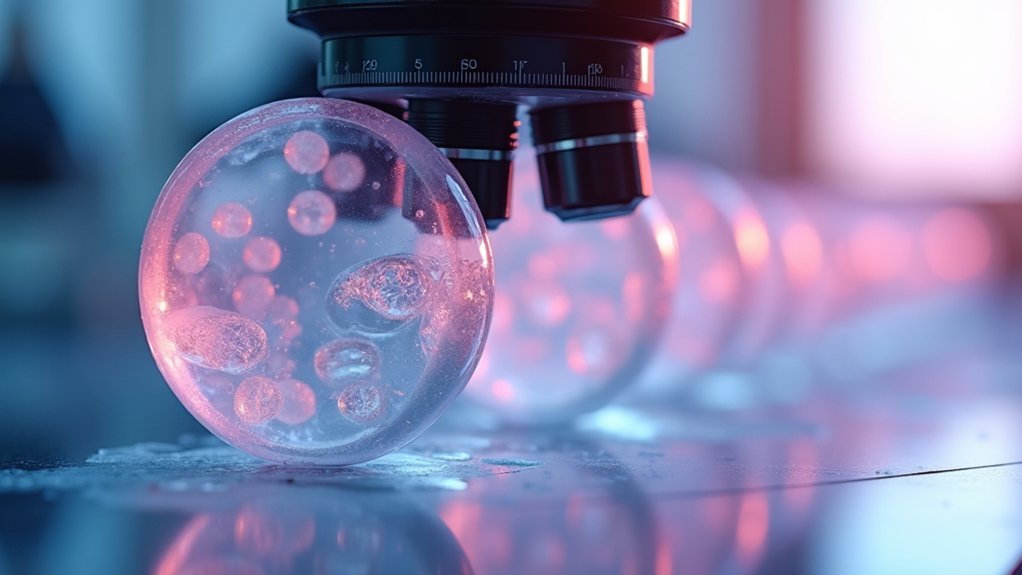
Proper alignment of your camera adapter stands as the cornerstone of successful microscopic imaging of cell specimens. Since focus is very shallow at high magnifications, make sure your adapter is firmly secured to the trinocular head with the correct diameter to prevent vignetting.
| Adapter Component | Common Issue | Solution |
|---|---|---|
| Connection point | Loose fitting | Tighten securely, use adapter ring if needed |
| Optical path | Misalignment | Calibrate to match microscope’s focal plane |
| Extension tubes | Incorrect distance | Add/remove tubes based on magnification |
Regularly clean all optical surfaces to prevent image degradation. For precise focus calibration, use Digicam Control software for real-time adjustments. Remember to account for coverslip thickness when calibrating—even minor variations can affect clarity when working with cell specimens.
Exposure Settings for High-Contrast Cell Boundaries
Achieving crisp, well-defined cell boundaries depends considerably on your exposure settings. Start with a low ISO (200-400) to minimize noise while maintaining clarity in bright conditions, especially important when using a macro lens for detailed cellular work.
Set your aperture between f/4 and f/5.6 to achieve sharp focus on cell structures while creating a softly blurred background that enhances contrast. Complement this with a fast shutter speed of at least 1/1000 second to eliminate motion blur, particularly with live specimens.
Bright field illumination works best for highlighting cell boundaries against contrasting backgrounds. For ideal results, adjust your exposure compensation toward slight underexposure, which preserves critical details in highlights and creates the high-contrast edges needed for clear cellular documentation.
Managing Vibration for Sharp Cellular Detail

Even the slightest vibration can ruin cellular photography, transforming crisp specimens into blurry, unusable images. To achieve peak sharpness, always place your microscope on a vibration-free surface and use a stable support for your camera.
Consider using a remote shutter release or cable release to eliminate physical contact with the camera during exposure. This simple step dramatically reduces movement-induced blur.
Eliminate camera contact with remote triggers—your cellular images will thank you with crystal-clear precision.
When shooting dynamic specimens, opt for high shutter speeds of 1/1000 second or faster to freeze cellular detail.
Test your setup’s stability by focusing on sharp specimens at high magnification. Look carefully for any signs of vibration in the preview image.
Confirm your oculars and focus finder are parfocal with the film plane, and regularly clean all optical surfaces to prevent dust from compromising image clarity.
Specimen Preparation to Enhance Focus Acquisition
Proper specimen preparation forms the foundation of successful focus acquisition, beginning with your selection of an appropriate coverslip no thicker than 1mm.
You’ll need to follow precise staining protocols that enhance cellular contrast while avoiding excessive background that can confuse autofocus systems.
When mounting your sample, make sure it’s positioned flat with suitable mounting media, as improper mounting techniques can create uneven focal planes that compromise even the most advanced microscopy systems.
Proper Slide Mounting Techniques
Three essential components of successful cell imaging begin with proper slide mounting techniques. Your specimen’s sharpness depends on how well you’ve secured it to the slide.
Always use a suitable mounting medium to prevent specimen movement during imaging, which disrupts focus quality.
For ideal results:
- Use clean, high-quality coverslips less than 1mm thick to maintain optical clarity and reduce distortion.
- Position the coverslip with its flat side facing the objective lens to facilitate accurate focus.
- Verify your slide surface is flat and stable to minimize vibrations that affect focus stability.
Regularly clean your slides and coverslips to remove dust or debris that could compromise focus quality.
These proper slide mounting techniques create the foundation for capturing crystal-clear cellular details in your microscopy work.
Sample Staining Protocols
While mounting techniques establish the physical foundation for your specimen, appropriate staining protocols determine how clearly your cells will appear under the microscope.
Implement double staining techniques using PI for nuclei and FITC for microtubules to enhance contrast during fluorescence illumination. This combination creates distinct boundaries between cellular components, dramatically improving focus acquisition.
Follow strict fixation protocols to maintain cellular integrity before applying stains. Remember that your mounting media should match your coverslip’s refractive index to prevent distortion during imaging.
For ideal results, verify your coverslips don’t exceed 1mm thickness, creating the perfect glass-air boundary for precise focusing.
Clean your slides thoroughly before and after staining to prevent contamination that could interfere with focus settings.
Well-executed sample staining protocols make the difference between blurry and crystal-clear cellular images.
Coverslip Thickness Considerations
Selecting the right coverslip thickness stands as the cornerstone of achieving perfect focus in cellular imaging. When preparing specimens for your light microscope, make certain coverslip thickness doesn’t exceed 1mm to maintain proper working distance with high-magnification objectives.
Position the coverslip facing downward toward the objective to enable effective light reflection necessary for Perfect Focus System operation.
For best results:
- Use standard glass coverslips that interact appropriately with the light path.
- Inspect coverslips before use to avoid scratches or contamination that compromise image clarity.
- Apply appropriate mounting media beneath the coverslip, as fixed samples without it won’t yield effective results with PFS.
Digital Post-Processing for Cell Structure Enhancement
After capturing your cell specimens, digital post-processing can dramatically improve the clarity and detail of your images. Use image editing software like Adobe Photoshop or Helicon Focus to adjust brightness, contrast, and sharpness for better visibility of cellular details.
Apply noise reduction filters to minimize graininess in high ISO images, resulting in cleaner visuals of cell structures. Enhance depth of field by implementing focus stacking—combining multiple images taken at different focal points to reveal intricate features throughout the specimen.
Correct chromatic aberrations and color balance to guarantee accurate representation, especially when working with stained specimens. For professional results, apply selective sharpening to cell structure edges without increasing background noise, keeping the viewer’s attention on the important cellular details.
Troubleshooting Common Focus Issues in Cell Microscopy
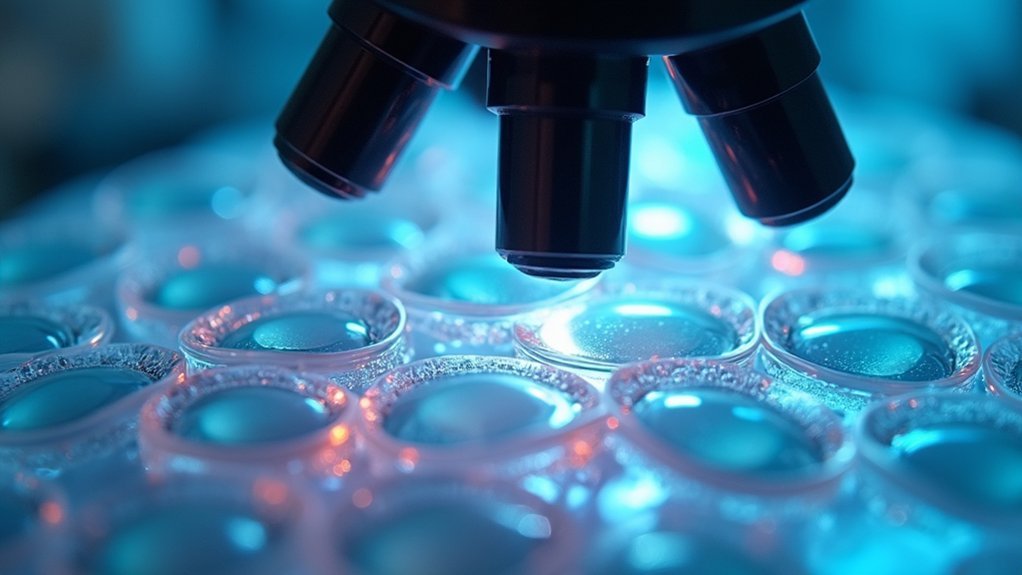
Even expert microscopists encounter focus problems that can compromise image quality and experimental results.
When taking pictures of cell specimens, maintaining perfect focus is essential for capturing detailed structures. If you hear a continuous tone during adjustment, simply reengage the PFS to restore proper function.
To guarantee peak focus when photographing cells:
- Always raise the objective until it contacts the oil on your sample before engaging the perfect focus system.
- Verify your coverslip is correctly oriented toward the objective, as PFS requires reflection from a glass-air or glass-water boundary.
- Clean your objective regularly to prevent oil contamination that disrupts focus quality.
Adjust the perfect focus offset using both coarse and fine adjustment settings until your cells appear crisp and clear in the viewfield.
Frequently Asked Questions
How Do You Get a Clearer Image on a Microscope?
To get a clearer microscope image, clean your objective lens, adjust the focus knob slowly, guarantee proper lighting, use the perfect focus system, and maintain the correct Z-position between 2000-3000 µm.
How to Set Camera for Clear Photo?
For clear photos, set your camera to aperture priority with f/4-6, use 1/200-1/500 second shutter speed, keep ISO between 200-400, and utilize remote control or tethering software to prevent camera shake.
In Summary
You’ll achieve the clearest cell specimen photos by combining proper microscope setup with strategic light management and depth of field control. Don’t forget to minimize vibration and prepare specimens carefully. When challenges arise, use focus stacking techniques and digital post-processing to enhance details. With practice, you’ll overcome common focus issues and consistently capture sharply detailed cellular structures for your research needs.

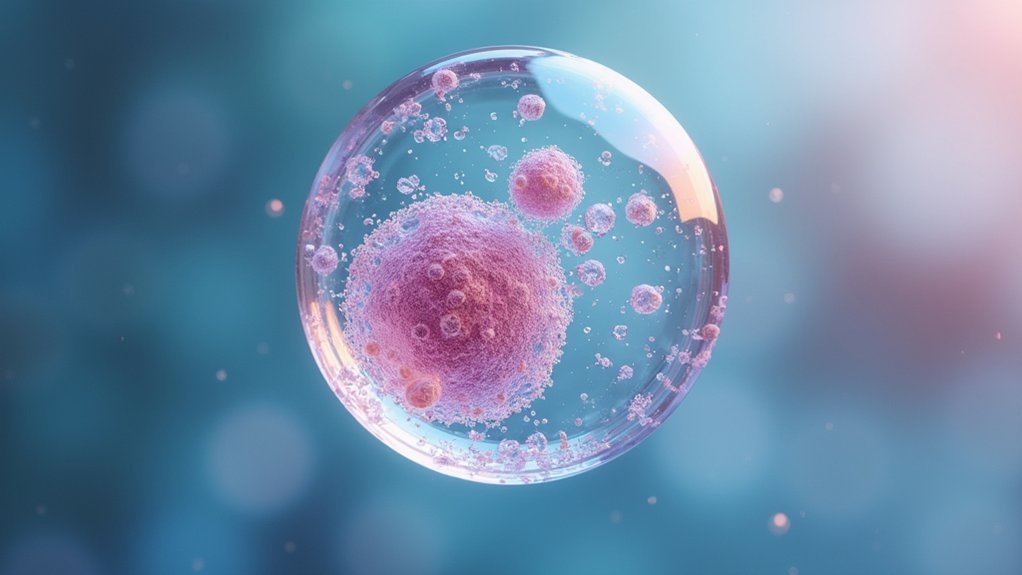



Leave a Reply